|
|
|
|||
|
|
||||
|
|
||||
| Smoke Trails | ||||
|
|
HOME | SITE MAP | FORUM | CONTACT |
|
||
|
ABOUT | MOTORS | MODELS | ARCHIVE | HISTORY | STORE | FAQ | LINKS
|
|
|
|
|
|
||||||||||||||||||||||||||||||||||||||||||||||||||||||||||||||||||||||||||||||||||||||||||||||||||||||||||||
|
Smoke Trails 6
(July 2006)
by Roger Simmonds Reprinted from SAM 35 Speaks, July 2006 Reactionary ruminations: Old Warden, May 13-14 Though there had been some ‘jet action’ at Middle Wallop earlier in the year, thanks mainly to Howard Metcalfe and Derek Knight, Old Warden was the first meeting of the year for most jet jockeys. Considering the recent Rapier supply situation and the less than ideal weather (intermittently wet and blustery) we had a magnificent turn out – Mike Stuart, André Bird, Derek Knight, Andies Blackwell and Sefton, John Digby and Steve Bage – to name but a few. Steve had come all the way from Aberdeen with an impressive collection, including his recently published Ohka, a Blom & Voss P.215, a Bachem Natter for L-2, and, lest anyone should think he is uninterested in vintage models, a DH 108 and an F9F-4 Panther. The latter is not the more familiar Keil Kraft design, but the 1958 Comet Kits design, featuring, as did the original, an internally mounted motor firing into an augmenter tube. |
|
||||||||||||||||||||||||||||||||||||||||||||||||||||||||||||||||||||||||||||||||||||||||||||||||||||||||||||

|
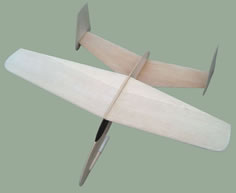 André Bird’s Duo Monoplane from Bill Dean
- Ruth Simmonds
|
||||||||||||||||||||||||||||||||||||||||||||||||||||||||||||||||||||||||||||||||||||||||||||||||||||||||||||
|
|
|
||||
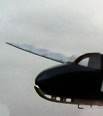
Derek Knight’s Cougar (right: 16" span, two KP 00 motors and five 50 mA NiCads driving a single fan) coped well with the conditions, as did Steve Bage’s well-trimmed models, the DH 108 and BV P.215 going particularly well. Steve also demonstrated the Natter and Ohka. Both needed a very hard chuck to get away; the Ohka, whether for compassionate or practical reasons (it has a very short nose), he flew without its pilot! If you picked your moment, trimming was possible in the calmer periods that coincided with thermal activity. This was fortunate for Mike Stuart, who had brought three previously untried models: a Skyleada YF-100, a Fiat G.91 (right), and a much-enlarged version of his SAAB Tunnan (below right). Mike was unsure if the Rapier L-3 would be powerful enough for his ‘Big Fat new Tunnan’ (BFT). Here is Mike’s report: “Saturday was probably the better flying day, despite the occasional shower, as the wind seemed a bit lighter. It changed round on Sunday and got windier as the day went on. Most people flew in the lee of the trees to give a maximum distance to the boundary hedge and road, but the air was pretty bumpy, with downdraughts, and it was actually better to fly from the runway, where the breeze was at least constant. “Two out of three of my new models flew; since they were the ones I designed, I can live with that! I was very nervous lighting up the BFT for the first time. I added a small tab to a wing trailing edge to get the glide straighter, and a bit of clay inside the nose intake to stop the glide being quite so floaty. Any doubts about whether the L-3 would provide enough thrust were dispelled when it headed skywards trailing smoke, before settling into a stately right hand spiral climb. The L-3s have a 23 second run, so by the time the motor cut it had gained considerable height, and headed off towards the road. At this point, I was wishing the glide was rather steeper, but after crossing the boundary hedge, it turned back and landed just inside the field. I flew it again on Sunday morning, nearly losing it in the farm next door before putting it back in the car. “I always thought the Fiat G.91 was a very pretty jet, and would make a good free flight subject, with the added attraction that I did not think anyone had done it before. There are some subtle contours on the fuselage that were tricky to get right, especially round the nose and tail, but I think it has come out looking reasonably accurate. The plan took rather longer to draw than my jets usually do, and I had to keep correcting and adjusting the drawings as the model progressed. The only intentional deviation from scale is the slightly enlarged tailplane. Wingspan is 13", and I hoped it would fly with a standard Rapier L-2. A small drag tab was needed on one wingtip trailing edge to straighten the glide as much as possible, but no nose or tail weight seemed to be needed. The first flight was with an 80 mN rated Rapier L-2LT, which had enough power to give a very pleasing sortie, with the model settling into a wide right circuit and gently climbing. This was followed by two flights using 110 mN rated L-2 motors, which showed a similar flight pattern, but gaining a bit more height. The model looked very stable and showed no tendency to drop a wingtip … as close as you can get to flying straight off the board”. Please contact Mike if you would like a plan. Mike had every expectation that the Skyleada YF-100 Super Sabre (right) would fly as well as the similar Mystère IV, which coped with the difficult conditions at Old Warden quite well, but this was not the case: “I never got anything resembling a full flight out of it [Mike confides], and after breaking a wing I decided the motor, though it matched the position of the Jetex 50 shown on the plan, was mounted too far forwards. It had a steep glide with a ‘full’ motor, but stalled with an empty one, and as soon as the nose came up the big flat fuselage bottom tended to flip it over.” All this was a trifle disappointing, especially as Replikit will be producing a range of Skyleada kits soon, including, I hope, the unique YF-100. Readers will remember Pete Smart was none too sanguine about this design (nor about its Gnat stablemate), and it does appear to be suffering from a version of ‘roll coupling’. But Mike is not easily deterred, and he is planning to move the Rapier back a little over an inch and add a thrust tab to see if this stabilises the flight pattern. |
|
 Andy Blackwell’s Coronette
- Ruth Simmonds
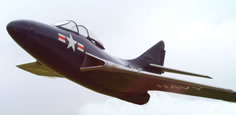 Derek Knight’s lovely Cougar
- Ruth Simmonds
 Mike Stuart’s Fiat G.91
- Mike Stuart
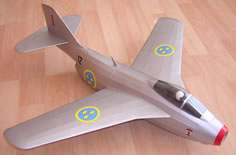 Mike Stuart’s 'Big Fat' Tunnan
- Mike Stuart
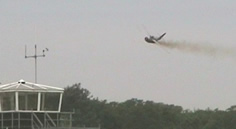 Mike Stuart’s Tunnan buzzes the control tower at Old Warden
- Russ Lister
 Mike Stuart launches his Fiat G.91 at Old Warden
- extracted from video shot by Graham Potter
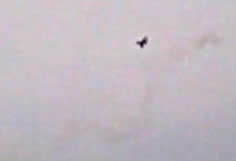 Mike Stuart’s Fiat G.91 over Old Warden
- extracted from video shot by Graham Potter
 Mike Stuart’s Skyleada YF-100 Super Sabre
- Mike Stuart
|
|||
|
If Mike’s Super Sabre was disappointing, it was more than made up for by Steve’s Panther (right), which, for the many of us who witnessed it, was the star of the show. Despite doubts about this design, and the squally conditions, it made several fine excursions over the field, smoke trailing from the jet pipe, and proving, once and for all, that Rapiers are compatible with augmenter tubes. Steve writes: ”I tried hard to save weight on the original over-engineered original Comet design. The wings and tail were totally re-designed, I used a very thin Clark-Y section on the wing and a much lighter structure. The fuselage had very heavy sheet fuselage keels, which I replaced with ”Being interested in the model’s accuracy, I overlaid the Comet plan over a 3-view, and was pleasantly surprised: the Comet plan is actually very accurate. The main discrepancies from scale are a slightly increased span and tail areas (very sensible) and an elliptical forward fuselage (which photos show to be circular). I had a close look at [Simon Mills’] Keil Kraft Panther. It was nicely built and performed very well, but it [Albert Hatfull’s design] really could have been a different aircraft altogether!”  The Comet F9F Panther (1958) – detail of fuselage construction. The designer appeared to believe that, like the original, the model needed to be stressed for carrier deck landings!
The Comet F9F Panther (1958) – detail of fuselage construction. The designer appeared to believe that, like the original, the model needed to be stressed for carrier deck landings!
- Comet Model Aeroplane and Supply Co.
Many thanks, Steve; if any reader fancies a copy of the Comet plan (below) – which could be modified to the rather prettier Cougar – Steve has a PDF version, and he is considering his own drawings based on his Panther ‘as built’. |
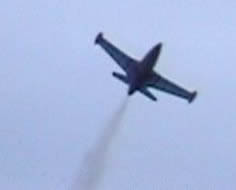 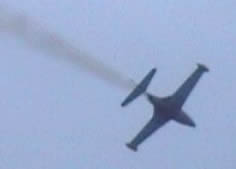 Steve Bage’s F9F-4, built from, or rather, perhaps, inspired by, the original 1958 Comet kit. It was unfinished for flight testing – very wise!
- Ruth Simmonds
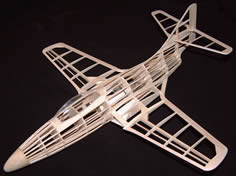 Steve Bage’s Panther in all its uncovered glory (and below, in covered glory). Historically, this was one of the very few kits, other those from Wilmot Mansour and Sebel, to feature an enclosed motor (Jetex 50 in this case) and augmenter tube. As can be appreciated, it’s a complex build, and Steve made many modifications to the rather agricultural original to simpilcate and add lightness. 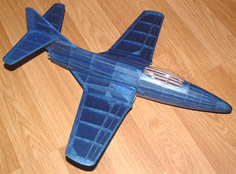
- Steve Bage
|
||||
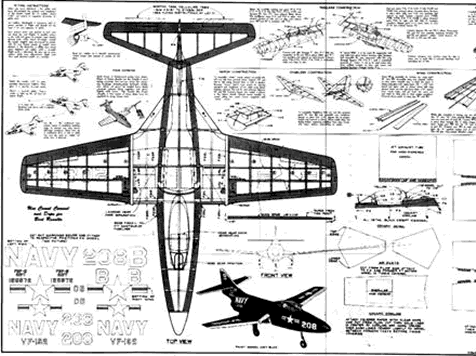 Steve’s magnificent model gives confidence that re-creations of the ‘Tailored’ range are perfectly feasible. Mike Stuart, I know, is planning to build an original Tailored Skyray (generously donated by Andy Blackwell) and Steve and I are both considering Fairey Delta IIs with internal Rapiers. All we need is a source of augmenter tubes, which, incidentally, appear to cope with Rapier exhaust much better than any of us expected. |
|
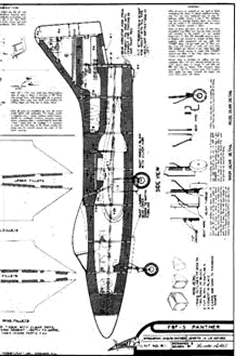
- Comet Model Aeroplane and Supply Co.
|
|||
|
The other Comet design seen at Old Warden, Lindsey Smith’s Bell Airacomet (right – see also ‘Scale Spot’ SAM 35 Speaks, February 2006) appeared rather over-powered by twin L-2LTs – it was going for the ‘continuous looping’ record on its maiden flight – so Lindsey says he will modify it for L-1s. Another hitherto unflown model, Derek’s new Supermarine type 525 (below right), needed somewhat calmer conditions to sort it out. This is a real beauty, with, like his Cougar, a fuselage of ‘hollow log’ construction. In consequence, it is, at 38 g, rather heavier than is the norm these days, and it might require a bit more power and a vigorous launch to get it away. Rather like the old Tailored models, in fact. Steve has already commented on Simon Mills’ Keil Kraft Panther. Simon, who has returned to rocket-propelled free flight after a hiatus of 30 years, also brought a Keil Kraft Hunter (why folk seem to prefer this one over the Skyleada design I do not know), an aged Skyjet and two of his own all sheet ‘semi-profile’ designs: a Skyray and a Javelin. These flew very well, and I hope I can persuade him to publish the plans in due course. To sum up the Old Warden is not easy. The weather could have been kinder; I would have loved to have seen the Coronette (which I built as a boy) in the air, and I would also have preferred not to have lost my F.D.2 to a CATO. But I wasn’t the only one to damage a model like this, as Steve’s Natter (below right) also suffered a burst motor (and the attentions of a ham-fisted baggage handler on the flight home to Aberdeen!). But, all in all, we had a great time. The hubris of the reactionary community is not abating; if anything, it is increasing: over the weekend we saw many smoke trails emanating from a variety of models – old, new, vintage, ‘retro’, profile, all-sheet, built-up, scale and non-scale. All this wonderful excitement was fuelled (if that is the right word) by the knowledge that George of SAMS Models had an ample supply of the new (brown cardboard) Rapiers (right). These proved reliable, with very few folk experiencing burst cases, and the ratings on the boxes accurately reflected, if not the absolute impulse, then their relationship to each other: i.e. L-2HP > L-2 (140) > L-2 (110) > L-2LT – which hasn’t always been the case. This is the good news about Rapiers. The bad news is that (a) they now cost a little more; (b) several fliers, including me, suffered poor performance and splits with motors that we had carefully been storing from last year. These motors were difficult to light (the bursts may have been due to over-enthusiastic ‘boring out’) and gave unpredictable thrust. It would appear that motors of 2004/2005 vintage do not keep, and my advice is to throw them out rather than risk losing a model. But should you, like me, have lost a model, and want something quick to put in the air, you could do a lot worse than try one of or Andy Sefton’s new profile models (stocked by SAMS). Andy’s Javelin, virtually a replica of the old Jetex model, is particularly pleasing, and he demonstrated how to achieve a predictable and stable flight pattern by paring away at the fin. Food for thought there, as to why this was needed. Or there is always something from Replikit. Mike Brannan, who didn’t realise ‘Jetex’ would be so popular when he started Replikit, is planning to produce a Skyleada Swift and Hunter. Now that we have a reliable Rapier L-3, I hope he will also include those other classic larger Ray Booth designs, the Comet and Vulcan. The YF-100 (not a Ray Booth design) is also on Mike’s list. Its plan will need, like Andy’s profile Javelin, modification in the light of recent flight testing. |
 Lindsey Smith’s Bell Airacomet, built from a Comet ‘Speedomatic’ kit design
- Lindsey Smith
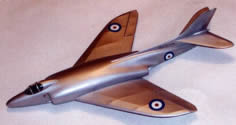 Derek Knight’s Supermarine 525
- Derek Knight
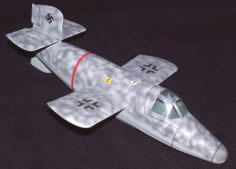 Steve Bage’s Bachem Natter
- Steve Bage
 2006 L-2HP Rapiers in brown cases
- Steve Bage
|
||||
|
ICI, Dr Hutchison’s twopence-ha’penny cartridges, and the Origins of Jetex
- Daily Mail, 13 March 1948
One of the first ‘Jetex’ patents was owned, not by Wilmot, Mansour & Company (WM), but by ICI. Granted just after the original WM patent, it protected their propellant formulations – but it also included details of a cardboard-bodied metal-capped motor (or ‘cartridge’), similar to a Rapier, that was never marketed. This has always been something of a puzzle, so it was with a real sense of anticipation that Andy Blackwell and I visited the author of this patent, Dr Alex Cantlay Hutchison (right), who had worked in the explosives (Nobel) division of ICI in Ardeer, Scotland, from 1939 to 1953. In an extended interview, Alex was able to correct several misconceptions and inaccuracies in the ‘authorised version’ of the ‘Story of Jetex’. He also shared his unique collection of press cuttings that recorded the extraordinary interest the first public demonstration of Jetex motors aroused. According to Alex, when the War began, he “was meant to be in Oxford doing work on cancer promoting substances, but that was cancelled”. Instead, he was recruited to work with James Taylor (ICI’s established expert on propellants), initially on rocket-powered torpedoes, and then on gas producing ‘power cartridges’ that had been used, amongst other things, to start aircraft engines. As to the beginnings of what became Jetex, Alex recalls: “The propellants we had, cordite, nitro-cellulose, things like that, were not suitable for rockets. They were too short burning; giving a PUNCH, rather than a prolonged force. So we looked for something that releases energy more slowly, but still giving good thrust, and that’s why we went to work on Ammonium Nitrate with a variety of additives. That was James Taylor’s work. He had gone on up the ladder before we came to Jetex and I was running the show myself. “After the War, we were thinking, ‘What can we do with some of the ideas we developed during the War for commercial industrial purposes?’ We tried to find propellant substances that would not be classified as explosives, so I started working on Guanidine Nitrate (GN) instead of Ammonium Nitrate. I discovered that by adding dinitro phenol with a catalyst I could get a very slow but complete reaction – turning the GN into gaseous substances, mostly water, CO2 and nitrogen. Instead of getting a cartridge that went bang, we had a cartridge that went ‘WOOSH’. By 1947, we were thinking of putting small [cardboard bodied] cartridges into toys, and had tested model aeroplanes with these. They were so good we started looking for somebody who might market the cartridges that we were proposing to manufacture. That’s when we stumbled into Wilmot Mansour, who, instead of a ‘throwaway’motor, were looking for something to go in their metallic re-usable motors. We invited Joe Mansour to come up and see what we had, and arranged for him to meet one of the schoolboys we knew had a good glider, which was very well balanced and glided beautifully. When we put a cartridge into it, it really was impressive. So I said, ‘This is what we should show Joe Mansour’. I took him out onto the golf course. He was very impressed indeed, and he said to the boy, ‘I’ll give you £5 for it’. The boy was amazed – five pounds in those days was at least £200 now. It was sold on the spot, and Joe Mansour went back home with the glider and a pocket full of cardboard cartridges.” Alex recollects Joe Mansour: “A very heavy smoker, he was very untidy, a real inventor type. He’d have a cigarette between his lips that would burn down depositing the ash down his front as it burned. There’s a funny story – one time we were flying aeroplanes at the golf course (my house was in a street that ran parallel to the golf course) and one that we let off was going particularly well, rising way up and over the course and disappeared over the houses. So Joe and myself went along the street pressing the bell of each house, asking, ‘Please can we come in and look in your garden for our aeroplane?’ It took a long time to live that down with the neighbours! “We still hadn’t at that stage decided whether we would continue to try to sell the cardboard cartridges, or supply pellets that Joe Mansour might insert into his aluminium motor. Eventually we decided his idea was much better, and it would be simpler for us to make just the pellets. Through late ’46 and through ’47, we worked to find out what size of pellet and so on (what thrust) while Mansour worked on how to make his. By 1948, Mansour was arranging for production and we were arranging for production. We had a whole range of the Power Cartridges that we thought we might demonstrate to industry in general, saying, ‘This is something you should be interested in and follow up’. The press came in great numbers to see what was on show … but when they discovered there was a small cartridge that was going to propel a model aeroplane, they all flung themselves at this, and that stole the show! Absolutely, the press coverage the next day was terrific … but it was all jet cartridges for toys! The Express, the Times, all the major papers carried good reports on, not ‘Jetex’, because it had no name at that time, but what was called ‘Dr Hutchison’s twopence-ha’penny cartridge’.” Wilmot Mansour did arrange their own demonstration later in 1948, of course, which had a much wider coverage in the model press, notably Aeromodeller. And the rest is history. I do not think the ‘Power Cartridges’ as such were much of a commercial success, but ICI did produce Jetex pellets to Dr Hutchison’s specification (which also covered the ‘Red Spot’ formulations) until 1957. Alex knows no reason why the prices were increased so greatly in the mid-fifties.
I hope the above edited extracts of our interview convey Alex’s enthusiasm and the pleasure he still feels in his achievements. Alex also discussed other important matters – propellant chemistry, his later research, rocket-propelled motorbikes! – and more extensive material still to be published on the Jetex.org website. In conclusion, I must thank Alex for so graciously sharing his reminiscences with us, to John Hartley (Alex’s son-in-law) for arranging the interview, and to Andy Blackwell for his meticulous preparation of the transcript. |
 Alex Hutchison, 2005
- John Hartley
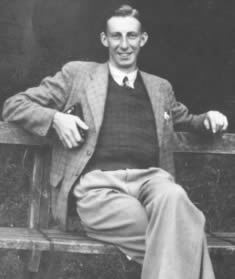
Alex Hutchison at the time of his work on Jetex fuel
- Alex Hutchison
 Was this the original schoolboy’s glider, now (over) powered by a Jetex 100, not an ICI cartridge?
- Daily Graphic, 13 March 1948
 First known photo of the Jetex 100
- Daily Graphic, 13 March 1948
 This tailless model is most unusual – was this flying shot faked? Is the model the right way up? It certainly does not appear to be the same as the tailless model in the group photo below. The bearded gentleman may be Wilmot Mansour designer Harold Figgins, who was later responsible for the WM Flying Wing.
- Daily Express, 13 March 1948
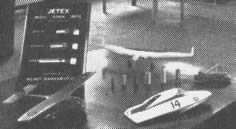 ICI’s display at their Ardeer Works. Note the familiar Hydrojet and RTP plane. Is the tailless model here a different one from that being flight tested in the photo above? Andy Blackwell is convinced is a scale Armstrong Whitworth AW 52.
- Chemistry and Industry, 3 April 1948
 This RTP car was known as the ‘Ardeer Arrow’
- Daily Mail, 13 March 1948
|
||||
|
|
|||||
|
|
|
||||
|
|
|
|
|
|
|
|
Acknowledgements - Article: Roger Simmonds - Illustrations: Steve Bage, John Hartley, Alex Hutchison, Terry Kidd, Derek Knight, Russ Lister, Ruth Simmonds, Lindsey Smith, Mike Stuart |
|
|
|
|
ABOUT | MOTORS | MODELS | ARCHIVE | HISTORY | STORE | FAQ | LINKS |
|
|
Terms of Use
|
Queries? Corrections? Additions?
Please
contact us.
|
|